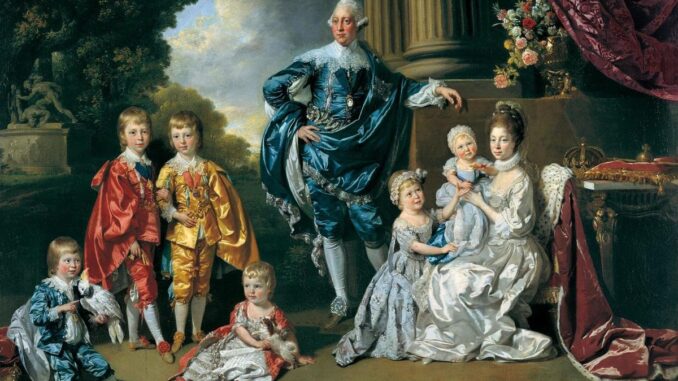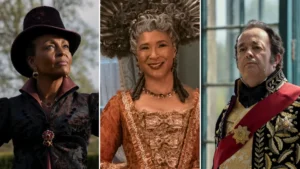
Queen Charlotte and King George III’s Family Tree
With the premiere of Queen Charlotte: A Bridgerton Story, take a closer look at Queen Charlotte’s family tree. (Yes, she really did have 15 children.)
The brand-new Netflix show, Queen Charlotte: A Bridgerton Story, chronicles the early years of Queen Charlotte and King George’s marriage. In a separate timeline, Queen Charlotte also explores the crisis an older Queen Charlotte has followed the death of her granddaughter, Princess Charlotte of Wales.
As Lady Whistledown narrates, “While our hearts grieve for the loss of the princess royal, our heads grieve more for the future of the monarchy itself. For the Crown now has a crisis on its hands. A crisis one can only imagine that Queen Charlotte must find galling after ruling over the matchmaking efforts of the ton and the marriage mart with such an iron fist. This author and all of England can only hope that Queen Charlotte finally turns her matchmaking energies onto her own family 13 children, and now, not a royal heir from any of them. At least, not a legitimate one.”
In episode one, viewers see Queen Charlotte upset with her children for not having legitimate marriages, and thus not providing any legitimate heirs to the throne. She admonishes all of them for being “virgins to the left of me, whores to the right,” and not giving her “legitimate grandbabies.”
“The only heir to the throne is dead,” she told her children. “I am stating facts: The princesses have had no babies, the princes have had a record number of babies. Illegitimate whore babies. We had one heir, one royal, and she is gone. Children, this is a crisis.” She commands, “One of you had better produce the next ruler of the United Kingdom, or your father’s line dies with him. Make me a royal baby.”

While much of Queen Charlotte is fictional, including depicting Charlotte as a Black woman (though some historians do believe the real Charlotte had distant African ancestry, she was, by all accounts, a white German noble), this succession crisis was based in fact. In 1817, when Princess Charlotte of Wales died, she was the only legitimate granddaughter of King George and Queen Charlotte. Eventually, George and Charlotte’s fourth son, Prince Edward, will have an heir: Princess Alexandrina Victoria—who will also later be known as Queen Victoria.
Queen Charlotte and King George III married on September 8, 1761, when George was 22 and Charlotte was 17 years old. Over the course of their 57 years of marriage, the royals welcomed 15 children, 13 of whom lived to adulthood. If we confirm Queen Charlotte and King George III’s family tree just to legitimate heirs, it looks like this:
Queen Charlotte
Queen Charlotte, born Sophia Charlotte of Mecklenburg-Strelitz on May 19, 1744, was the daughter of Duke Charles Louis Frederick of Mecklenburg-Strelitz and Princess Elizabeth Albertina of Saxe-Hildburghausen. She grew up at Untere Schloss (Lower Castle) in Mirow, in northern Germany, and married King George III when she was just 17 years old. A year later, gave birth to their first child. Charlotte was the UK’s longest-serving Queen Consort, and died at age 74 at Dutch House (now Kew Palace) on November 17, 1818. Along with many other kings and queens, Charlotte is buried at St George’s Chapel at Windsor Castle.
King George III
King George III, born Prince George William Frederick of Wales on June 4, 1738, was the eldest son of Frederick, Prince of Wales and Augusta of Saxe-Gotha. His grandfather was King George II. When his father Prince Frederick died unexpectedly in 1751 at age 44, George became apparent heir. In 1760, George III became monarch when his grandfather died. During his 60-year reign, several major world events occurred, including the Seven Years War, the American Revolutionary War, and the Battle of Waterloo. Throughout his life, he suffered from mental illness, often manifesting as acute mania—contemporary historians think he may have had bipolar disorder, but there’s no way to confirm this diagnosis. After he became unable to rule beginning in 1810, his eldest son became Prince Regent in 1811. He died on January 29, 1820 at the age of 81.
